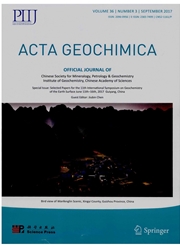

 中文摘要:
中文摘要:
Fankou Pb-Zn 存款是在中国的很重要、著名的存款。Pb-Zn 丰富的时间在这存款很长时间被辩论了。三节的十七件样品的一个总数为矿化作用时间和矿石形成的机制的学习从 Fankou 矿被拿。样品被显微镜, Soxhlet 摘录, GC,和 GC/MS 方法分析。结果显示器官的体积参数在不同样品与 Pb-Zn 内容变化并且被矿石硫化物形成清楚地影响。有机性地 geochemical 参数(MPI 1, CPI ) 显示在 Fankou 存款的 paleotemperatures 是比在所有三节的 80 ° C 低的。在墙岩石中的硫化物可能在如此的低温度由 PR,而非由 TSR 由 BSR 或部分主要在 synsedimentation 或早成岩作用期间发生,这个阶段可以是第一个矿化作用阶段。差错附近的硫化物可能被 TSR 在沉积以后形成,这个阶段可以是第二个矿化作用阶段。
 英文摘要:
英文摘要:
The Fankou Pb-Zn deposit is a very important and famous deposit in China. The time of Pb-Zn enrichment has been debated for a long time in this deposit. A total of seventeen samples of three sections were taken from the Fankou mine for the study of mineralization time and the mechanism of ore formation. The samples were analyzed by microscope, Soxhlet-extract, GC, and GC/MS methods. The results indicated that organic bulk parameters vary with the Pb-Zn contents in different samples and clearly were influenced by ore sulfide formation. Organically geochemical parameters (MPI 1, CPI) indicate that the paleotemperatures in the Fankou deposit are lower than 80℃ in all three sections. Sulfides in the wall rocks might occur mainly during synsedimentation or early diagenesis by BSR Or partly by PR, rather than by TSR at such low temperatures, this stage may be the first mineralization stage. Sulfides near the faults might be formed by TSR after sedimentation, this stage may be the second mineralization stage.
 同期刊论文项目
同期刊论文项目
 同项目期刊论文
同项目期刊论文
 Recovery of origin organic parameters of the samples from the outcropping source rocks in the Shiwan
Recovery of origin organic parameters of the samples from the outcropping source rocks in the Shiwan 期刊信息
期刊信息
